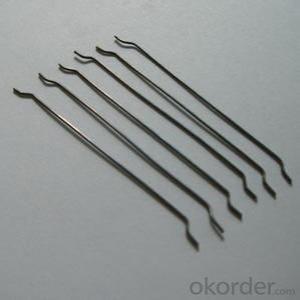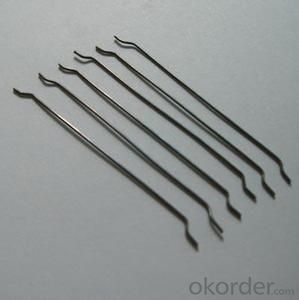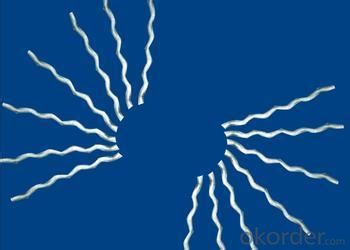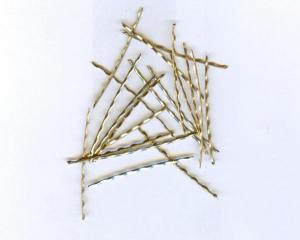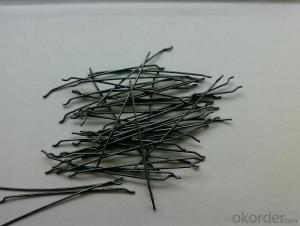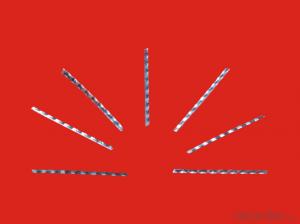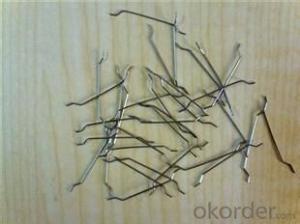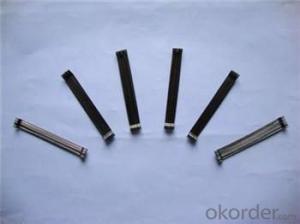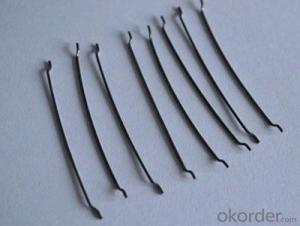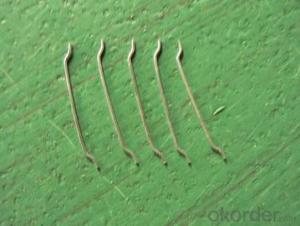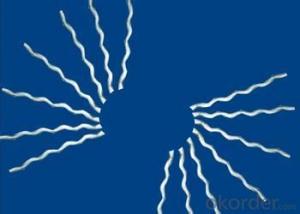Glued hooked-end steel fiber from CNBM China
- Loading Port:
- Tianjin
- Payment Terms:
- TT OR LC
- Min Order Qty:
- 1 m.t.
- Supply Capability:
- 10000 m.t./month
OKorder Service Pledge
Quality Product, Order Online Tracking, Timely Delivery
OKorder Financial Service
Credit Rating, Credit Services, Credit Purchasing
You Might Also Like
Quick Details
Place of Origin: Tianjin, China (Mainland)
Model Number: 0.9
Material: Steel
Production Process: Cold drawn
Lengh: 55
Type: 1
Compressive Strength: >1200MPa
Aspect ratio: 61
Standard: ASTM A820M-11
Section Shape: Circular
Application: Concrete Reinforcement
Packaging & Delivery
| Packaging Details: | 20 kg/Bag,50 bags/Pallet or 1,000kg/ Bulk Bag |
|---|---|
| Delivery Detail: | 1 Month |
Product Description
| Diameter | 0.90 | mm | 0.04 | in |
| Length | 55.00 | mm | 2.16 | in |
| Aspect Ratio | 61 | |||
| Tensile strength | 1200 MPa | |||
| Type | Cold drawn Steel Fiber | |||
| End | Hooked-end Steel Fiber | |||
| Glued/Loose | Glued Steel Fiber | |||
| Bending Angle | 45°(min.30°) | |||
| Usage & Performance | Floor:Trafficked areas and Industrial floors | |||
| Shotcrete :Slope stabilization and Final lining | ||||
| Precast concrete:Pipe and Railway sleepers | ||||
| Packing | Standard Export Pallet Packing | Bag Packing | 20 kg/Bag,50 bags/Pallet | |
| Bulk Packing | 1,000kg/ Bulk Bag | |||
| Loading Quantity | 20’GP | 20-25 Tonne/Tonnes | ||
| 40’GP | 25-27 Tonne/Tonnes | |||
| 40’HQ | 25-27 Tonne/Tonnes | |||
| MOQ | 1 kg for trial order | |||
| Supply Ability | 10,000 Tonne/Tonnes per Year | |||
| Payment Terms | T/T or L/C at sight | |||
| Delivery Time | Within 15 days after receiving deposit or original L/C at sight | |||
| Certification | ISO9001:2000, CE, | |||
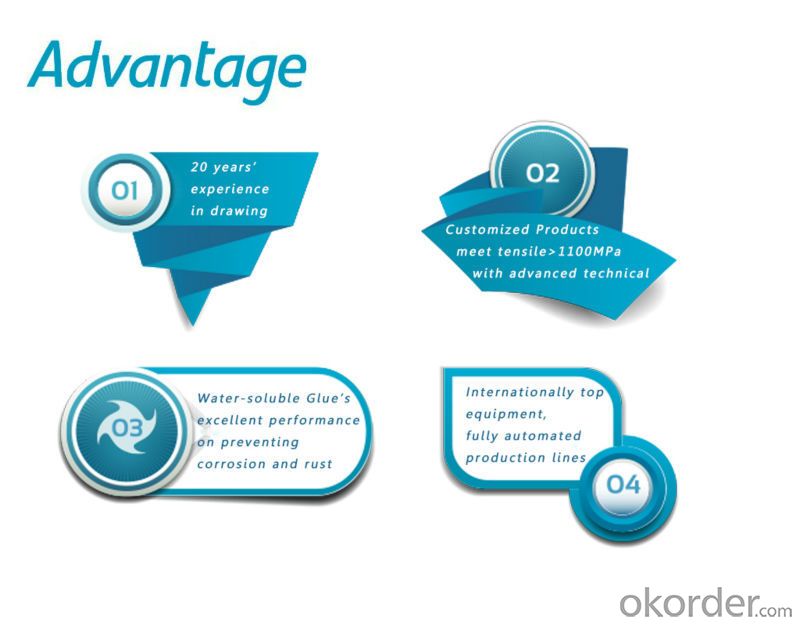
| Product | Diameter | Length mm/in | Aspect Ratio | Type | Packing |
| G-6030 | 0.5 mm (0.0197 in) | 30 mm (1.1811 in) | 60 | Glued | 20 kg/Bag, or 1,000kg/ Bulk Bag |
| G-6535 | 0.55 mm (0.0217 in) | 35 mm (1.3780 in) | 65 | Glued | 20 kg/Bag, or 1,000kg/ Bulk Bag |
| G-6035 | 0.6 mm (0.0236 in) | 35 mm (1.3780 in) | 60 | Glued | 20 kg/Bag, or 1,000kg/ Bulk Bag |
| G-8060 | 0.75 mm (0.0295 in) | 60 mm (2.3622 in) | 80 | Glued | 20 kg/Bag, 50 bags/Pallet |
| G-6060 | 0.9 mm (0.0354 in) | 60 mm (2.3622 in) | 60 | Glued | 20 kg/Bag, 50 bags/Pallet |
| G-6030 | 0.5 mm (0.0197 in) | 30 mm (1.1811 in) | 60 | Loose | 20 kg/Bag, or 1,000kg/ Bulk Bag |
| G-6535 | 0.55 mm (0.0217 in) | 35 mm (1.3780 in) | 65 | Loose | 20 kg/Bag, or 1,000kg/ Bulk Bag |
| G-6035 | 0.6 mm (0.0236 in) | 35 mm (1.3780 in) | 60 | Loose | 20 kg/Bag, or 1,000kg/ Bulk Bag |
| G-8060 | 0.75 mm (0.0295 in) | 60 mm (2.3622 in) | 80 | Loose | 20 kg/Bag, 50 bags/Pallet |
| G-6060 | 0.9 mm (0.0354 in) | 60 mm (2.3622 in) | 60 | Loose | 20 kg/Bag, 50 bags/Pallet |
- Q:What is the effect of melt extract stainless steel fiber on the modulus of rigidity of concrete?
- Concrete's modulus of rigidity is generally improved by the addition of melt extract stainless steel fibers. These fibers reinforce the concrete matrix, enhancing its overall performance and mechanical properties. The modulus of rigidity, or shear modulus, measures a material's stiffness and ability to resist deformation under shear stress. By incorporating stainless steel fibers, the modulus of rigidity is increased, resulting in a more rigid and durable concrete structure. Stainless steel fibers act as reinforcement within the concrete, providing additional strength and improving its tensile strength and crack resistance. This reinforcement prevents cracks from propagating and enhances the concrete's ability to withstand external loads and stresses. Furthermore, the inclusion of melt extract stainless steel fibers enhances the flexural strength of the concrete, enabling it to withstand bending forces without failure. This contributes to the overall rigidity of the concrete structure. The stainless steel fibers also help to evenly distribute applied loads throughout the concrete, reducing localized stress concentrations. This leads to a more uniform distribution of forces, ultimately enhancing the modulus of rigidity. In conclusion, the addition of melt extract stainless steel fibers has a positive impact on the modulus of rigidity of concrete, resulting in a stronger and more durable material. These improved mechanical properties make it suitable for various applications requiring high-performance concrete, such as infrastructure projects, industrial flooring, and seismic-resistant structures.
- Q:Can melt extract stainless steel fiber be used in high-temperature refractory applications?
- Yes, melt extract stainless steel fiber can be used in high-temperature refractory applications.
- Q:What is the effect of melt extract stainless steel fiber on the modulus of brittleness of concrete?
- The inclusion of melt extract stainless steel fiber has a significant impact on the brittleness modulus of concrete, reducing it greatly. In order to enhance the toughness and ductility of concrete, stainless steel fibers are usually incorporated into concrete mixes. These fibers are dispersed throughout the concrete matrix, acting as reinforcement and promoting a more even distribution of stress. As a result, the concrete becomes more resistant to cracking and exhibits increased flexural strength. Furthermore, the addition of stainless steel fibers aids in the control and limitation of crack propagation within the concrete, effectively decreasing its brittleness. These fibers act as a barrier, preventing cracks from spreading further and thus contributing to the durability and resilience of the material. Ultimately, this improved crack resistance and enhanced ductility contribute to an increase in the brittleness modulus of concrete. Melt extract stainless steel fibers, in particular, are renowned for their exceptional tensile strength and resistance to corrosion. This makes them an ideal choice for reinforcing concrete structures in harsh environments, such as coastal areas or those exposed to chemicals. By incorporating melt extract stainless steel fibers into concrete, the overall performance and longevity of the material are greatly improved. To summarize, the introduction of melt extract stainless steel fibers into concrete results in a significant reduction in its brittleness modulus. This is achieved by enhancing the material's toughness, ductility, and crack resistance. The end result is a concrete that is more durable and resilient, capable of withstanding higher levels of stress and strain without experiencing failure.
- Q:Does melt extract stainless steel fiber improve the resistance to sulfate attack of shotcrete?
- Yes, melt extract stainless steel fiber does improve the resistance to sulfate attack of shotcrete.
- Q:How does melt extract stainless steel fiber improve the resistance to seismic loading in shotcrete?
- Melt extract stainless steel fiber improves the resistance to seismic loading in shotcrete by enhancing the overall structural integrity and ductility of the material. When added to shotcrete, stainless steel fibers act as reinforcement, providing additional strength and toughness to the concrete mixture. During seismic events, such as earthquakes, shotcrete structures are subjected to dynamic forces that can cause cracking and failure. However, the inclusion of stainless steel fibers helps to distribute these forces more evenly throughout the material, reducing the concentration of stress points and minimizing the risk of structural damage. Stainless steel fibers also improve the bond between the shotcrete and the substrate, enhancing the overall adhesion and cohesion of the material. This is particularly crucial in seismic loading scenarios, as it ensures that the shotcrete remains firmly attached to the underlying structure, effectively resisting the lateral forces induced by the seismic event. Furthermore, the high tensile strength and corrosion resistance of melt extract stainless steel fibers make them an ideal choice for seismic-resistant shotcrete. These fibers are capable of withstanding significant tensile stresses and do not degrade over time, even in harsh environmental conditions. This longevity ensures that the shotcrete maintains its structural integrity and seismic resistance over the long term. In summary, melt extract stainless steel fiber improves the resistance to seismic loading in shotcrete by strengthening the material, enhancing its bond with the substrate, and providing long-lasting durability. By incorporating these fibers into shotcrete mixtures, engineers can confidently design structures that can withstand the dynamic forces associated with seismic events.
- Q:How does melt extract stainless steel fiber improve the mechanical properties of concrete?
- Melt extract stainless steel fiber improves the mechanical properties of concrete through various mechanisms. Firstly, the addition of stainless steel fiber enhances the tensile strength of concrete by bridging cracks that may develop due to shrinkage or external loading. This bridging effect prevents crack propagation and increases the overall tensile capacity of the concrete. Additionally, stainless steel fibers act as reinforcement within the concrete matrix, providing increased resistance to bending and flexural stresses. This reinforcement effect helps to distribute load more evenly throughout the concrete, thereby reducing the risk of localized failures and enhancing the overall structural integrity. Moreover, the high aspect ratio and excellent adhesion of stainless steel fibers to the concrete matrix contribute to improved impact and fatigue resistance. These fibers effectively absorb and dissipate energy during dynamic loading, making the concrete more resistant to cracking and deformation under repeated or sudden loading conditions. Furthermore, the corrosion resistance of stainless steel fibers ensures long-term durability of the concrete. Unlike traditional reinforcement materials such as steel bars, stainless steel fibers do not corrode in the presence of moisture and aggressive chemicals. This corrosion resistance extends the service life of the concrete and maintains its mechanical properties over time. In summary, melt extract stainless steel fiber improves the mechanical properties of concrete by enhancing tensile strength, flexural resistance, impact resistance, fatigue resistance, and corrosion resistance. These improvements lead to a more durable and reliable concrete structure, capable of withstanding various types of loading and environmental conditions.
- Q:How does melt extract stainless steel fiber enhance the fatigue resistance of concrete?
- Melt extract stainless steel fiber enhances the fatigue resistance of concrete by providing additional reinforcement and improving its structural integrity. The incorporation of these fibers in concrete mixtures creates a three-dimensional reinforcement network that helps to distribute and dissipate stress and load throughout the material. This network acts as a barrier to crack propagation, preventing the formation and growth of micro-cracks that can eventually lead to fatigue failure. The high tensile strength and ductility of stainless steel fibers allow them to effectively absorb and disperse energy during cyclic loading, thereby reducing the stress concentration at potential crack initiation points. As a result, the fatigue life of the concrete is significantly improved, as the fibers help to prevent the development of cracks and extend the overall durability and lifespan of the structure. Additionally, the corrosion resistance of stainless steel fibers is crucial in enhancing the fatigue resistance of concrete. Unlike other types of fibers, stainless steel fibers are not susceptible to corrosion from exposure to moisture, chemicals, or environmental factors. This corrosion resistance ensures that the fibers retain their effectiveness and integrity over time, even in harsh conditions, further enhancing the fatigue resistance of the concrete. Overall, the incorporation of melt extract stainless steel fibers in concrete improves its fatigue resistance by providing additional reinforcement, reducing crack propagation, absorbing and dispersing energy, and enhancing its durability and corrosion resistance. This results in a more resilient and long-lasting concrete structure, particularly in applications subjected to cyclic loading and fatigue stress.
- Q:Can melt extract stainless steel fiber be used in lightweight aggregate concrete?
- Yes, melt extract stainless steel fiber can be used in lightweight aggregate concrete. Stainless steel fibers are commonly added to concrete mixtures to improve its properties such as strength, ductility, and durability. Lightweight aggregate concrete is a type of concrete that uses lightweight aggregates instead of traditional aggregates, resulting in a lower density and reduced weight. Adding stainless steel fibers to lightweight aggregate concrete can enhance its mechanical performance and resistance to cracking, making it a suitable option for various applications. However, it is important to ensure that the stainless steel fibers are properly dispersed and mixed within the concrete to achieve the desired benefits.
- Q:How does melt extract stainless steel fiber improve the impact resistance of concrete pavers?
- Melt extract stainless steel fiber improves the impact resistance of concrete pavers through its unique properties and characteristics. When added to the concrete mix, these fibers act as reinforcing elements, providing enhanced toughness and durability to the pavers. The primary reason for the improved impact resistance is the high tensile strength of stainless steel fibers. These fibers are manufactured using a melt extraction process, which ensures a consistent and uniform distribution of fibers throughout the concrete matrix. This distribution helps in evenly dispersing the stress caused by an impact, preventing the concentration of forces on specific areas of the pavers. Furthermore, the stainless steel fibers also increase the flexural strength of the concrete pavers. This means that the pavers can withstand bending forces caused by impacts without cracking or breaking. The fibers act as a reinforcement network, reinforcing the cementitious matrix and preventing the propagation of cracks. In addition to the increased strength, stainless steel fibers also improve the overall durability of concrete pavers. The stainless steel material is highly resistant to corrosion, which is especially beneficial in outdoor or high-moisture environments. This resistance ensures that the fibers retain their strength and integrity over time, further enhancing the impact resistance of the pavers. Overall, melt extract stainless steel fiber significantly improves the impact resistance of concrete pavers by providing enhanced tensile strength, flexural strength, and durability. The incorporation of these fibers into the concrete mix results in pavers that can withstand heavy loads, impacts, and other external forces without compromising their structural integrity.
- Q:What is the recommended fiber dosage for melt extract stainless steel fiber in shotcrete?
- The fiber dosage recommended for melt extract stainless steel fiber in shotcrete usually falls between 25 and 35 kg/m3. Nevertheless, it is crucial to consider that the precise dosage may differ based on various factors like the desired strength, durability, and overall performance demands of the shotcrete application. It is advisable to seek guidance from the manufacturer or a structural engineer to ascertain the ideal fiber dosage for the particular project.
1. Manufacturer Overview |
|
|---|---|
| Location | |
| Year Established | |
| Annual Output Value | |
| Main Markets | |
| Company Certifications | |
2. Manufacturer Certificates |
|
|---|---|
| a) Certification Name | |
| Range | |
| Reference | |
| Validity Period | |
3. Manufacturer Capability |
|
|---|---|
| a)Trade Capacity | |
| Nearest Port | |
| Export Percentage | |
| No.of Employees in Trade Department | |
| Language Spoken: | |
| b)Factory Information | |
| Factory Size: | |
| No. of Production Lines | |
| Contract Manufacturing | |
| Product Price Range | |
Send your message to us
Glued hooked-end steel fiber from CNBM China
- Loading Port:
- Tianjin
- Payment Terms:
- TT OR LC
- Min Order Qty:
- 1 m.t.
- Supply Capability:
- 10000 m.t./month
OKorder Service Pledge
Quality Product, Order Online Tracking, Timely Delivery
OKorder Financial Service
Credit Rating, Credit Services, Credit Purchasing
Similar products
New products
Hot products
Hot Searches
Related keywords
